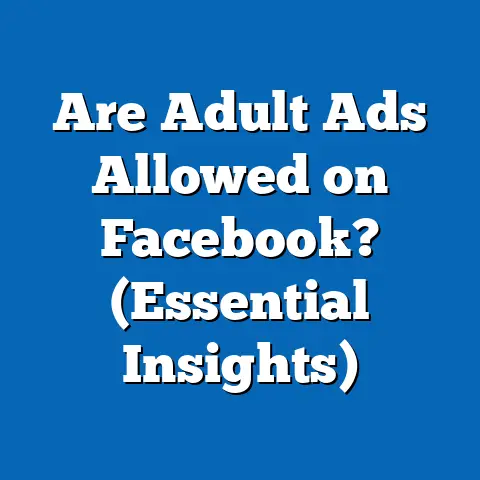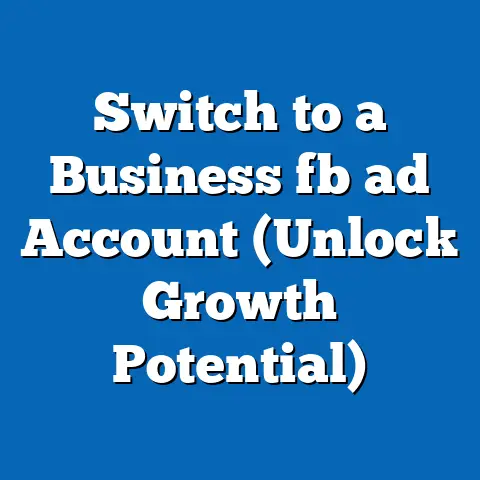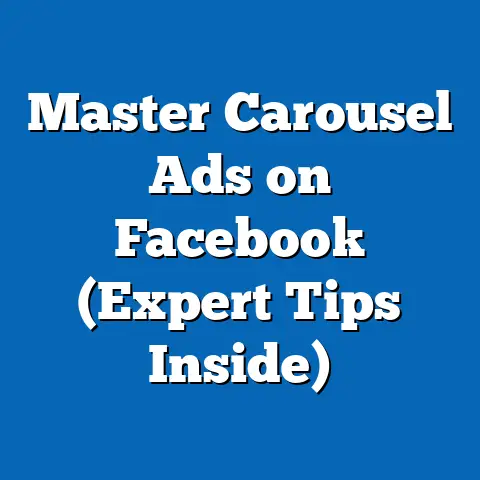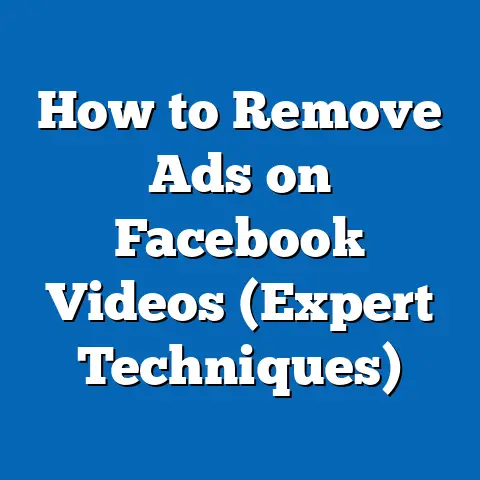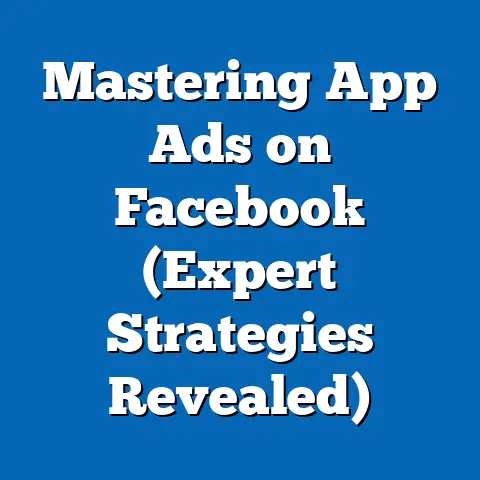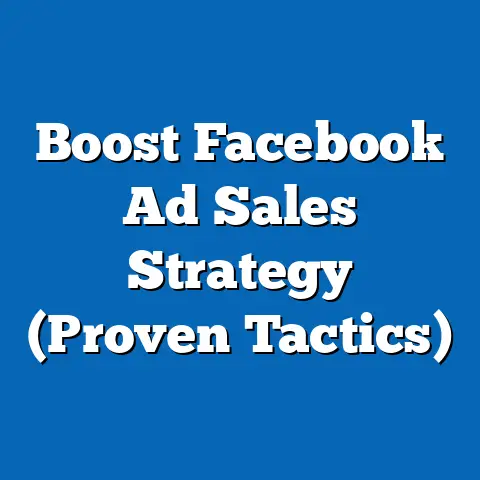Master Effective Facebook Advertising (Proven Strategies)
Facebook advertising has become an undeniable force in the digital marketing landscape. With billions of active users, it offers unparalleled reach and targeting capabilities for businesses of all kinds. But let’s be honest, navigating the ever-evolving world of Facebook Ads Manager can feel like trying to solve a Rubik’s Cube blindfolded. I’ve spent years working with Facebook ads, and I’ve seen firsthand what works and what doesn’t.
In the eco-tech sector, the stakes are even higher. You’re not just selling a product or service; you’re promoting a vision of a better future. Your target audience – environmentally conscious consumers – are discerning and value authenticity. They want to support businesses that align with their values and make a positive impact on the planet. This is where effective Facebook advertising, done right, becomes crucial.
This guide isn’t just about the technical aspects of running Facebook ads. It’s about crafting a strategy that resonates with your target audience, builds trust, and drives meaningful results for your eco-tech business. Let’s dive into the proven strategies that will help you master Facebook advertising and achieve sustainable success.
Section 1: Understanding Facebook Advertising
Facebook advertising offers a powerful platform for businesses to connect with potential customers. With its vast user base, it provides unparalleled reach, allowing you to target specific demographics, interests, and behaviors. This is particularly valuable for eco-tech businesses looking to reach environmentally conscious consumers.
The sheer scale of Facebook is staggering. As of 2024, Facebook boasts over 3 billion monthly active users globally. This massive audience presents a huge opportunity for businesses to connect with potential customers. But it’s not just about the numbers; it’s about reaching the right people.
One of the key strengths of Facebook advertising is its sophisticated targeting capabilities. You can target users based on a wide range of criteria, including age, gender, location, interests, education, and even their online behavior. For eco-tech businesses, this means you can specifically target users who are interested in sustainability, environmentalism, and related topics.
There are several different types of Facebook ads you can choose from, each with its own strengths and weaknesses:
- Image Ads: These are simple ads that feature a single image and accompanying text. They’re great for showcasing your products or services in a visually appealing way.
- Video Ads: Video ads are more engaging than image ads and can be used to tell a story, demonstrate a product, or share a message. I’ve found video ads perform exceptionally well for showcasing the impact of eco-friendly products.
- Carousel Ads: Carousel ads allow you to showcase multiple images or videos in a single ad. This is a great option for highlighting different features of a product or showcasing a range of products.
- Collection Ads: Collection ads are designed to drive product discovery and sales. They feature a visually appealing layout that showcases your products and makes it easy for users to browse and purchase them.
- Lead Ads: Lead ads are designed to collect leads from potential customers. They feature a simple form that users can fill out without leaving Facebook. This is a great option for building your email list or generating leads for your sales team.
The Facebook Ads Manager is your central hub for creating, managing, and tracking your Facebook ads. It provides a comprehensive set of tools for everything from setting your budget and targeting your audience to tracking your ad performance and optimizing your campaigns.
Takeaway: Facebook advertising offers unparalleled reach and targeting capabilities for eco-tech businesses. Understanding the different types of ads and the features of the Ads Manager is essential for creating effective campaigns.
Section 2: Defining Your Target Audience
Before you even think about creating an ad, you need to have a crystal-clear understanding of who you’re trying to reach. Who are your ideal customers? What are their values, interests, and motivations? What problems are they trying to solve?
This is where buyer personas come in. A buyer persona is a semi-fictional representation of your ideal customer, based on research and data about your existing customers. Creating buyer personas will help you understand your target audience better and tailor your ads to their specific needs and interests.
When creating buyer personas for your eco-tech business, consider the following factors:
- Demographics: Age, gender, location, income, education, occupation.
- Values: What’s important to them? Are they passionate about sustainability, environmentalism, animal welfare, or social justice?
- Interests: What are their hobbies and interests? Do they enjoy hiking, gardening, cooking, or other eco-friendly activities?
- Motivations: What are they trying to achieve? Are they looking to reduce their carbon footprint, live a healthier lifestyle, or support ethical businesses?
- Pain Points: What problems are they trying to solve? Are they struggling to find sustainable products that meet their needs, or are they concerned about the environmental impact of their purchasing decisions?
Once you’ve created your buyer personas, you can use them to inform your Facebook advertising strategy. Facebook’s targeting options allow you to target users based on a wide range of criteria, including:
- Interests: Target users who are interested in specific topics, such as sustainability, environmentalism, renewable energy, or organic food.
- Behaviors: Target users who have exhibited certain behaviors, such as purchasing eco-friendly products, donating to environmental organizations, or attending sustainability events.
- Demographics: Target users based on their age, gender, location, income, education, or occupation.
- Custom Audiences: Create custom audiences based on your existing customer data, such as email lists or website visitors.
- Lookalike Audiences: Create lookalike audiences based on your existing customer data. This allows you to target users who are similar to your best customers.
Takeaway: Defining your target audience is crucial for creating effective Facebook ads. Create buyer personas that reflect the values and preferences of eco-conscious consumers, and use Facebook’s targeting options to reach the right people.
Section 3: Crafting Compelling Ad Content
Now that you know who you’re trying to reach, it’s time to craft ad content that resonates with them. This means writing compelling headlines, descriptions, and calls-to-action that align with eco-tech values.
Eco-conscious consumers are discerning and value authenticity. They want to support businesses that are transparent, ethical, and committed to sustainability. This means your ad content needs to be genuine and avoid greenwashing. Don’t make exaggerated claims or mislead consumers about the environmental benefits of your products.
When writing ad copy, focus on the following:
- Highlight the benefits: Instead of just listing the features of your product, focus on the benefits it provides. How will it help your customers live a more sustainable lifestyle?
- Use strong visuals: Choose images and videos that are visually appealing and relevant to your target audience. Show your products in action, and highlight their environmental benefits.
- Tell a story: Share your sustainability journey and the impact of your products. This will help you connect with your audience on an emotional level and build trust.
- Use a clear call-to-action: Tell your audience what you want them to do. Do you want them to visit your website, purchase a product, or sign up for your email list? Make it easy for them to take action.
Here are some examples of compelling ad copy for eco-tech businesses:
- “Reduce your carbon footprint with our energy-efficient solar panels. Save money on your electricity bill and help protect the planet.”
- “Our organic cotton clothing is made from sustainably sourced materials and produced in ethical factories. Shop our collection today and support a better future.”
- “Join our community of eco-conscious consumers and learn how you can make a difference. Sign up for our email list and receive exclusive discounts and tips.”
Takeaway: Crafting compelling ad content is essential for capturing the attention of eco-conscious consumers. Focus on authenticity, transparency, and storytelling to build trust and drive engagement.
Section 4: Leveraging Facebook Tools and Features
Facebook offers a range of powerful tools and features that can enhance your advertising efforts and help you achieve your goals. Here are some of the most important ones:
- Facebook Pixel: The Facebook Pixel is a small piece of code that you can install on your website. It allows you to track the actions that users take on your website after clicking on your Facebook ad. This data can be used to optimize your ads and target your audience more effectively. I’ve found the Pixel to be absolutely essential for retargeting and conversion tracking.
- Custom Audiences: Custom Audiences allow you to target users based on your existing customer data, such as email lists or website visitors. This is a great way to reach your most loyal customers and drive repeat sales.
- Lookalike Audiences: Lookalike Audiences allow you to target users who are similar to your best customers. This is a great way to expand your reach and find new customers who are likely to be interested in your products or services.
- Facebook Insights: Facebook Insights provides detailed data about your ad performance, including reach, engagement, and conversions. This data can be used to analyze your ad performance and make data-driven decisions about your advertising strategy.
- A/B Testing: A/B testing allows you to test different versions of your ads to see which one performs best. This is a great way to optimize your ads and improve your results.
Let’s dive deeper into how these tools can be used effectively:
- Using Facebook Pixel for Retargeting: Imagine someone visits your website, checks out a specific product, but doesn’t make a purchase. With the Facebook Pixel, you can show them ads specifically for that product, reminding them of their interest and encouraging them to complete the purchase.
- Creating Custom Audiences from Email Lists: Upload your email list to Facebook and create a Custom Audience. You can then target these users with ads that are tailored to their specific interests and needs.
- Leveraging Lookalike Audiences to Expand Reach: Once you have a Custom Audience of your best customers, you can create a Lookalike Audience to target users who are similar to them. This allows you to reach a wider audience of potential customers who are likely to be interested in your products or services.
Takeaway: Facebook offers a range of powerful tools and features that can enhance your advertising efforts. Leverage these tools to target your audience more effectively, track your ad performance, and optimize your campaigns.
Section 5: Budgeting and Bidding Strategies
Setting an appropriate advertising budget is crucial for maximizing your ROI. How much should you spend on Facebook ads? The answer depends on a variety of factors, including your business goals, target audience size, and the competition in your industry.
As a general rule, it’s best to start with a small budget and gradually increase it as you see results. This will allow you to test different strategies and optimize your campaigns without breaking the bank.
There are several different bidding strategies you can choose from, including:
- Cost-Per-Click (CPC): You pay each time someone clicks on your ad. This is a good option if you’re focused on driving traffic to your website.
- Cost-Per-Impression (CPM): You pay for every 1,000 impressions of your ad. This is a good option if you’re focused on building brand awareness.
- Cost-Per-Action (CPA): You pay each time someone takes a specific action, such as purchasing a product or signing up for your email list. This is a good option if you’re focused on driving conversions.
The right bidding strategy for you will depend on your business goals and target audience. If you’re just starting out, it’s best to experiment with different bidding strategies to see which one works best for you.
Here are some tips for monitoring and adjusting your budget:
- Track your ad performance: Monitor your ad performance regularly and make adjustments as needed.
- Set a budget limit: Set a budget limit to prevent overspending.
- Pause underperforming ads: Pause ads that are not performing well.
- Increase your budget for successful ads: Increase your budget for ads that are performing well.
Takeaway: Setting an appropriate advertising budget and choosing the right bidding strategy is crucial for maximizing your ROI. Monitor your ad performance regularly and make adjustments as needed.
Section 6: Measuring Success and Adjusting Strategies
You’ve launched your Facebook ad campaigns, but the work doesn’t stop there. In fact, it’s just beginning! Measuring your success and adjusting your strategies is an ongoing process that’s essential for maximizing your ROI.
There are several key performance indicators (KPIs) that you should monitor to assess the effectiveness of your Facebook ads:
- Reach: The number of people who saw your ad.
- Impressions: The number of times your ad was displayed.
- Click-Through Rate (CTR): The percentage of people who clicked on your ad after seeing it.
- Conversion Rate: The percentage of people who took a desired action after clicking on your ad, such as purchasing a product or signing up for your email list.
- Cost Per Acquisition (CPA): The cost of acquiring a new customer through your Facebook ads.
- Return on Ad Spend (ROAS): The amount of revenue you generate for every dollar you spend on Facebook ads.
- Engagement Rate: This measures how people interact with your ad (likes, shares, comments). A high engagement rate often indicates that your ad resonates with your target audience.
By tracking these KPIs, you can get a clear picture of how your ads are performing and identify areas for improvement. For example, if your CTR is low, you may need to revise your ad copy or visuals. If your conversion rate is low, you may need to improve your landing page or streamline your checkout process.
Continuous optimization is essential for maximizing your ROI. This means regularly analyzing your ad performance and making adjustments as needed. Here are some tips for continuous optimization:
- A/B test different ad formats and messages: Experiment with different ad formats and messages to see which ones perform best.
- Refine your targeting: Continuously refine your targeting to reach the right audience.
- Optimize your landing page: Make sure your landing page is optimized for conversions.
- Monitor your competitors: Keep an eye on your competitors to see what they’re doing.
- Stay up-to-date with the latest Facebook advertising trends: Facebook is constantly evolving, so it’s important to stay up-to-date with the latest trends and best practices.
Takeaway: Measuring your success and adjusting your strategies is an ongoing process that’s essential for maximizing your ROI. Track your KPIs, analyze your ad performance, and make adjustments as needed.
Conclusion
Mastering Facebook advertising is essential for eco-tech businesses looking to connect with environmentally conscious consumers and achieve sustainable success. By understanding the platform, defining your target audience, crafting compelling ad content, leveraging Facebook tools and features, setting an appropriate budget, and continuously optimizing your campaigns, you can create effective Facebook ads that drive meaningful results.
Don’t be afraid to experiment and try new things. The world of Facebook advertising is constantly evolving, so it’s important to stay curious and keep learning. And remember, authenticity and transparency are key. Be genuine in your messaging and avoid greenwashing at all costs.
Now it’s your turn. Take the strategies outlined in this guide and start your Facebook advertising journey with confidence and creativity. The planet (and your business) will thank you for it!

